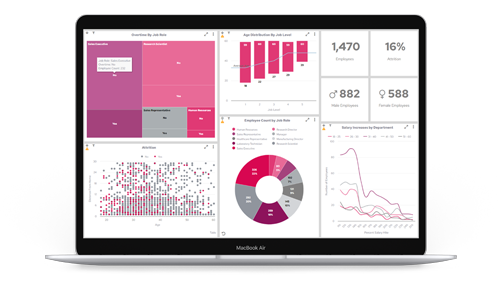What is data driven analytics?
Data driven analytics refers to the process of collecting, analyzing, and interpreting large volumes of data to make informed business decisions. This approach leverages statistical methods, algorithms, and machine learning techniques to uncover patterns, trends, and insights that can drive strategic initiatives. By focusing on empirical data rather than intuition or guesswork, organizations can enhance their decision-making processes, optimize operations, and improve overall performance.
In the context of Software as a Service (SaaS), data-driven analytics enables companies to understand user behavior, predict future trends, and tailor their offerings to meet customer needs more effectively.
The importance of data driven analytics in SaaS
In the competitive landscape of SaaS, leveraging data-driven analytics is no longer optional. It’s a necessity. Companies that integrate analytics into their SaaS platforms can make informed decisions, optimize operations, and enhance user experiences. This approach allows businesses to stay ahead of the curve by understanding user behavior, predicting trends, and making data-backed decisions.
Why is data-driven analytics of interest to companies?
By leveraging data insights, businesses can make more informed decisions, enhance customer experiences, and drive operational efficiencies. Here are some key reasons why data-driven analytics is of paramount interest to companies:
Strategic decision-making
Data driven analytics provide a comprehensive view of how users interact with a SaaS product. This insight is invaluable for making strategic decisions that drive growth. By analyzing data, companies can identify patterns and trends that inform product development, marketing strategies, and customer support initiatives. This leads to a more efficient and effective business model.
Enhancing user experience with embedded analytics
Embedded analytics play a crucial role in enhancing the user experience within SaaS applications. By integrating analytics directly into the application, users can access real-time data insights without switching between multiple platforms. This seamless integration ensures that users have the information they need at their fingertips, improving their overall experience.
For instance, a Healthtech SaaS application can use embedded analytics to provide healthcare professionals with real-time patient data. This allows for quicker decision-making and better patient outcomes. Similarly, in Fintech, embedded analytics can help financial advisors make more informed investment decisions by providing them with up-to-date market data.
Driving operational efficiency
Operational efficiency is a key benefit of data driven analytics in SaaS. By analyzing data, companies can identify inefficiencies and areas for improvement. This leads to streamlined processes and reduced operational costs. For example, predictive analytics can forecast demand, allowing companies to optimize inventory levels and reduce waste.
Automation and productivity
Moreover, data driven analytics can automate routine tasks, freeing up employees to focus on more strategic initiatives. This not only improves productivity but also enhances job satisfaction. In the long run, these efficiencies contribute to the overall growth and success of the SaaS business.
Predictive insights for future planning
Predictive analytics is a powerful tool for future planning in SaaS. By analyzing historical data, companies can predict future trends and make proactive decisions. This is particularly useful in industries like retailtech, where understanding consumer behavior is crucial for staying competitive.
For example, a Retailtech SaaS application can use predictive analytics to forecast sales trends and optimize inventory management. This ensures that popular products are always in stock, improving customer satisfaction and boosting sales. Similarly, in Edtech, predictive analytics can help educators identify students at risk of falling behind and provide targeted interventions to improve learning outcomes.
Ensuring data security and compliance
Data security and compliance are critical considerations for any SaaS company. With the increasing amount of data being generated and analyzed, it’s essential to ensure that this data is secure and compliant with relevant regulations. Data-driven analytics can help companies achieve this by providing robust security features and compliance tools.
For instance, multi-tenanted security ensures that each user’s data is isolated and protected. This is particularly important in industries like Fintech, where data breaches can have severe consequences. Additionally, compliance tools can help companies adhere to regulations like GDPR, ensuring that user data is handled responsibly and ethically.
Self-service dashboards for empowered users
Self-service dashboards are a key feature of data-driven analytics in SaaS. These dashboards allow users to access and analyze data on their own, without needing to rely on IT or data specialists. This empowers users to make data-driven decisions and enhances their overall experience with the SaaS product.
For example, a self-service dashboard in a Healthtech SaaS application can allow healthcare professionals to track patient outcomes and identify areas for improvement. Similarly, in Fintech, self-service dashboards can provide financial advisors with real-time market data, enabling them to make informed investment decisions.
Scalable solutions for growing businesses
Scalability is a crucial consideration for any SaaS company. As businesses grow, their data needs will also increase. Data-driven analytics provide scalable solutions that can grow with the business. This ensures that companies can continue to leverage data insights as they expand.
For instance, a growing Edtech company can use scalable analytics solutions to manage increasing amounts of student data. This allows them to continue providing personalized learning experiences as their user base grows. Similarly, a Retailtech company can use scalable analytics to manage larger inventories and optimize supply chain operations.
The benefits of being data driven
Adopting a data-driven approach offers numerous advantages:
- Accurate and objective decisions: By relying on data, companies can make more precise and unbiased decisions, leading to better outcomes.
- Growth opportunities: Data-driven strategies help in identifying new opportunities for growth and expansion.
- Optimized resource allocation: Efficient use of resources is achieved by analyzing data to determine the best allocation.
- Improved customer satisfaction: Understanding customer needs through data helps in enhancing their overall experience.
- Agility and adaptability: Data-driven organizations can quickly adapt to market changes, giving them a competitive edge.
Key takeaways
In conclusion, data driven analytics play a vital role in the growth and success of SaaS companies. By integrating analytics into their platforms, companies can enhance user experiences, drive operational efficiency, and make informed decisions. Predictive insights, data security, self-service dashboards, and scalable solutions are just a few of the benefits that data-driven analytics provide.





















